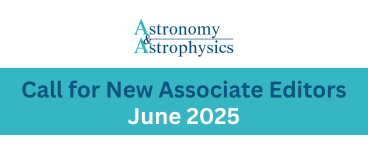A&A special issue (August 2018): Gaia Data Release 2
- Details
-
Published on 30 August 2018
Astronomy & Astrophysics, published by EDP Sciences, has published a special issue on the second data release (DR2) of the Gaia space mission which has been recording astrometric and photometric measurements since July 2014.
Gaia is an astrometric space observatory developed by the European Space Agency. It is devoted to measuring the position, distance and movement of stars. Gaia DR2 is based on the analysis on the first 22 months of the mission and the data release gives an insight into its full potential. It represents “a game-changing leap for stellar and Galactic astronomy” ( Forveille, T., Kotak, R., Shore, S. and Tolstoy, E., A&A 616, E1 (2018) ).
To read the special issue, please click here
Astronomy & Astrophysics turns 50
- Details
-
Published on 14 May 2018
15th May 2018 marks the beginning of the 50th anniversary of Astronomy & Astrophysics (A&A)1,2. A year-long programme of events will begin today at the annual meeting of A&A Board of Directors at the European Southern Observatory (ESO) in Garching, Germany.
The anniversary marks a significant milestone for one of the leading original research journals in the field. Since its launch half a century ago as the fusion of 6 national journals and in collaboration with ESO, A&A has published nearly 650 volumes and special issues, disseminating the highest quality scientific research to the academic community. Since 2008, A&A has been also supporting early career researchers through its Scientific Writing for Young Astronomers residential seminars to provide guidance on writing for professional publications.
The anniversary will be marked by several events with a highlight at the General Assembly of the International Astronomical Union in Vienna, Austria (August 20th- 31st 2018).
1The member countries of A&A are: Argentina, Armenia, Austria, Belgium, Bulgaria, Chile, Croatia, Czech Republic, Denmark, Estonia, Finland, France, Germany, Greece, Hungary, Italy, Lithuania, Netherlands, Norway, Poland, Portugal, Slovak Republic, Spain, Sweden, Switzerland
2A&A is currently published by EDPS.




























